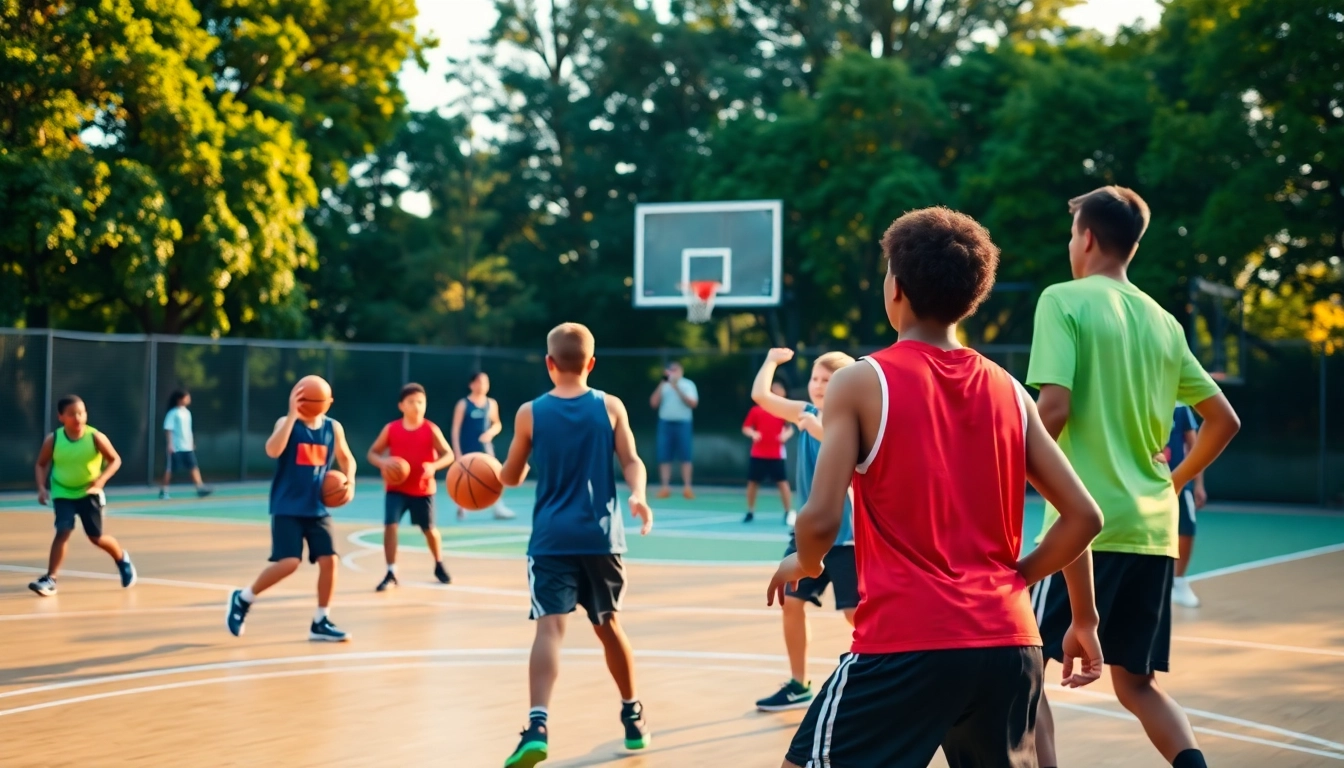Understanding Basketball Training Programs
What Are Basketball Training Programs?
Basketball training programs are structured methods designed to enhance a player’s skills, physical abilities, and overall performance in the game. These programs can range from individual drills to comprehensive training camps, encompassing various components such as shooting, dribbling, defense, and conditioning. The primary goal is to build both foundational skills for beginners and advanced techniques for seasoned players. With the rise of technology, many programs now offer online training options that make them accessible to a wider audience.
Benefits of Structured Training
Structured basketball training programs provide numerous benefits that can significantly impact an athlete’s overall game. Firstly, they offer a systematic approach to skills development, ensuring players focus on specific areas requiring improvement. Training under the guidance of experienced coaches helps players to learn and correct movements, ultimately leading to better performance in live games. Additionally, participation in such programs fosters discipline, teamwork, and motivational habits that are invaluable both on and off the court. Players can also benefit from the networking opportunities that arise through structured training, allowing connections with other athletes and coaches.
Types of Basketball Training Programs Available
There are several types of basketball training programs available today. Here are the prominent categories:
- Individual Training Sessions: Tailored one-on-one training focusing on personal skills and needs.
- Group Clinics: Small group sessions that encourage competition and teamwork.
- Online Programs: Virtual classes that allow athletes to train from anywhere, often with video demonstrations and feedback.
- Summer Camps: Intense, often week-long programs designed to immerse participants in basketball training filled with drills, strategy sessions, and games.
- Strength and Conditioning Programs: Programs that focus on enhancing physical fitness specific to basketball, such as agility, strength, and endurance.
Evaluating the Best Basketball Training Programs
Key Features to Look For
When searching for the best basketball training programs, there are several key features that should be evaluated. First, consider the qualifications and experience of the coaching staff. Coaches who have played at a collegiate or professional level often bring invaluable insights to their training methods. Next, evaluate the curriculum offered — programs should cover a range of skills and have measurable goals. Additionally, consider the facility’s quality and equipment availability, along with flexible scheduling options to accommodate busy athletes. Finally, look for feedback or testimonials from former participants to gauge the program’s effectiveness.
How to Assess Training Effectiveness
Assessing the effectiveness of any basketball training program can involve several strategies. One method is to track performance metrics, such as shooting percentage, free throw success rate, and overall game statistics before and after participation in the training. Another approach is soliciting feedback from coaches on noticeable improvements in a player’s skills and decision-making in games. Also, establishing short-term and long-term goals can allow players to measure their progress incrementally. Regular assessments provide insight into a player’s evolution and highlight areas still needing focus.
Understanding Different Coaching Styles
Coaching styles can dramatically influence the effectiveness of training programs. Some coaches may adopt a more authoritarian style, emphasizing strict discipline and adherence to structured training regimens. Others might favor a democratic style, encouraging athlete input in practice plans and fostering a more collaborative environment. It’s important for players to find a coaching style that resonates with them to maximize their training experience. Engaging with different styles can sometimes help identify which approach yields the best results depending on the athlete’s learning preferences and types of feedback they respond to best.
Top Competitors in Basketball Training
Overview of Leading Basketball Training Organizations
Several organizations have established themselves as leaders in basketball training, each offering unique programs and methodologies. For instance, Evolution Basketball Training excels in creating personalized training plans, producing notable successes with over 500 college players developed. Similarly, Pro-Fit Basketball offers comprehensive training options catering to players at every level, ensuring broad accessibility and a range of developmental paths. The Jordan Lawley Training focuses on online course formats making it easier for athletes to access professional guidance at their convenience.
Comparative Analysis of Training Methods
Comparative analysis of various basketball training methods can provide insights into what might work best for different players. For instance, traditional in-person training typically allows for immediate feedback and hands-on corrections from coaches. In contrast, online training often offers flexibility in scheduling and a wider variety of resources but may lack the personalized attention of in-person sessions. When choosing between these methods, consider your unique schedule, learning style, and the specific skills you wish to enhance. Additionally, combining methods—such as pairing online drills with in-person coaching—can create a well-rounded training experience.
Success Stories from Participants
Success stories from participants in basketball training programs lend credibility to their effectiveness. Many athletes report significant improvements in their game after completing structured training courses. For example, a player who engaged in a summer camp with thoroughly designed drills and competitions may leave with enhanced shooting form and increased confidence to take shots under pressure. Testimonials often cite not only technical skill improvement but also broader personal development such as teamwork, leadership, and resilience. Documenting and sharing these success stories can inspire future participants and validate the program’s value.
Popular Training Drills for Skill Development
Essential Drills for Beginners
For beginners, foundational basketball drills are crucial. Drills focusing on basic skills such as dribbling, passing, and shooting create the backbone of a player’s development. Some essential drills include:
- Dribble Relay: Players race while dribbling, enhancing ball handling and speed.
- Shooting Form Drill: Repeating proper shooting mechanics using one hand to develop muscle memory.
- Partner Passing: Practicing chest passes and bounce passes with a partner fosters precision and timing.
Advanced Drills to Master
Advanced players need to refine their skills with more complex drills. These may include:
- Pick-and-Roll Execution: Practicing the pick-and-roll tactic with teammates to develop offensive strategies.
- Isolation Moves: Working on various isolation techniques to enhance one-on-one offensive skills.
- Defensive Slides: Training footwork and quick lateral movements to improve defensive capabilities.
Incorporating Conditioning into Training
No training program is complete without a focus on conditioning. Basketball is a high-intensity sport requiring both aerobic and anaerobic fitness. Incorporating circuit training, sprint intervals, and plyometrics into a training session can prepare players to perform under fatigue while also enhancing their speed, agility, and strength. For optimal results, a conditioning program should align with basketball skill development, allowing players to build endurance without compromising their technical training focus.
Maintaining Motivation in Basketball Training
Setting Realistic Goals for Progress
Setting realistic goals is essential for maintaining motivation during training. Players should focus on short-term, attainable objectives that lead toward larger aspirations. For example, rather than just striving to make the varsity team, a player might set a goal to improve their free throw percentage by 10% over the next month. This kind of structured goal-setting instills a sense of achievement and propels continuous improvement.
Keeping Training Fun and Engaging
To sustain interest in the training process, it is crucial for programs to incorporate fun and engaging elements. Coaches can bring enthusiasm to drills by gamifying practices, introducing friendly competitions, or allowing players input into practice setups. Using technology such as training applications that track progress or provide drill ideas can also keep training fresh and innovative, enhancing both enjoyment and competitiveness.
Tracking Your Improvements
Tracking progress is vital for motivation and can help players visualize their improvements over time. This could involve maintaining a training journal to note skills practiced, personal bests achieved, and feedback received from coaches. Additionally, using video analysis tools can allow players to review footage of their play, enabling them to recognize progress and areas needing improvement clearly. Celebrating milestones—no matter how small—can foster a positive mindset and drive continued effort towards self-improvement.



